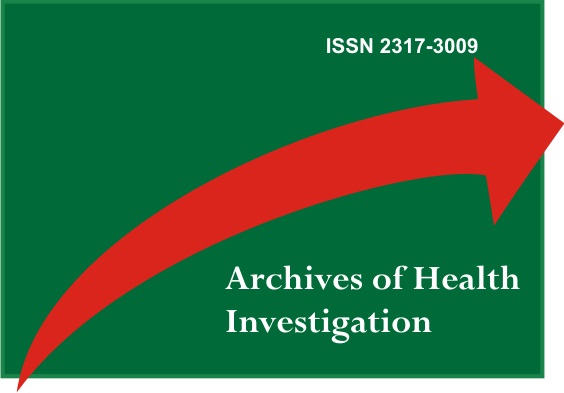Direct tracks in the treatment of child brussels: case report
DOI:
https://doi.org/10.21270/archi.v10i6.5001Keywords:
Bruxism, Orthodontics, Pediatric Dentistry, StressAbstract
Introduction: Infantile bruxism is an unconscious act that may be linked to hereditary and psychological factors, a functional disorder, which is characterized by the typical gnashing of teeth, with extremely high occlusal forces when compared to normal that are capable of generating, in the medium and long term, great consequences. Objective: To report a clinical case of preparation and installation of flat direct clues in a child patient, carried out at the School of Dentistry Clinic of the Federal University of Campina Grande (UFCG), in order to consider the efficacy of the treatment. Case report: This study presents the case of a 10-year-old infant patient who sought dental care complaining of bruxism. Through anamnesis and clinical examination, it was possible to observe the presence of this dysfunction. The proposed treatment was installation of flat direct clues in lower molars. The procedure was initiated from anatomical molding with infant trays 2 and alginate type ll, followed by leakage of the cast in plaster. With leaked models, composite resin and resin spatula were used to make the tracks, polishing them adapted in the pumice model. The installation was preceded by prophylaxis, acid attack and rinsing, adhesive insertion and light curing. The tracks were individually adapted with the aid of flow resin and photoactivation in elements 74, 75, 84, 85. Conclusion: The treatment chosen was based on a very practical and reversible technique, which demonstrated great success and provided muscle relaxation with consequent absence of symptomatology.
Downloads
References
Lipp Men, Souza EAPS, Romano ASF, Colovan MA. Como enfrentar o stress infantil. São Paulo: Ícone; 1991.
Kristensen CH, Schaefer LS, Busnello FB. Estratégias de coping e sintomas de stress na adolescência. Estud psicol. 2010;27(1):21-30.
Sbaraini CR, Schermann LB. Prevalence of childhood stress and associated factors: a study of schoolchildren in a city in Rio Grande do Sul State, Brazil. Cad Saúde Pública. 2008; 24(5):1082-88.
Attanasio, R. Nocturnal bruxism and its clinical management. Dent Clin North Am; 1991;35(1):245-52.
Vanderas A.P. Relationship between craniomandibular dysfunction and oral parafunctions in Caucasian children with and without unpleasant life events. J Oral Rehabil; 1995;22:289-94.
Loos PJ, Aaron GA. Standards for management of the pediatric patient with acute pain in the temporomandibular joint or muscles of mastication. Pediatr Dent; 1989;11(4):331.
Okeson, J. P. Fundamentos de oclusão e desordens têmporo-mandibulares. 2. ed. São Paulo: Artes Médicas; 1992, p.118-135.
Feitosa GMA, Félix RCR, Sampaio DC, Vieira ARG, Santos CCO, Fonseca ST. Bruxismo na infância: perfil de comportamento, características do sono e sintomatologia. Rev Bahiana Odontol. 2016;7(2):94-104.
Vieira ARG, Drumond CL, Martins PA Jr, Corrêa FP, Gonzaga GC, Marques LS, et al. Prevalence of sleep bruxism and associated factors in preschool children. Pediatr Dent. 2014;36(1):46-50.
Serra NJM, Paiva SM, Auad SM, Ramos JML, Pordeus IA. Signs, symptoms, parafunctions and associated factors of parent-reported sleep bruxism in children: a case-control study. Braz Dent J. 2012;23(6):746-52.
Castroflorio T, Bargellini A, Rossini G, Cugliari G, Rainoldi A, Deregibus A. Risk factors related to sleep bruxism in children: a systematic literature review. Arch Oral Biol. 2015; 60(11):1618-24.
Ahmad, R. Bruxism in children. J Pedodont; 1986, v.10, p.105-125.
Maciel, R. N. Oclusão e ATM: procedimentos clínicos. São Paulo: Santos; 1996.
Calderan MF, Silva TC, Honório DR, Oliveira TM, Machado MADAM. Fatores etiológicos do bruxismo do sono: revisão de literatura. Rev Odontol Univ Cid São Paulo.2017;26(3):243-49.
Halal CSE, Nunes ML. Education in children’s sleep hygiene: which approaches are effective? A systematic review. J Pediatr. 2014;90(5):449-56.
Alves VC, Moliterno LF, Ramos ME, Cruz RA, Campos V. Alguns aspectos do bruxismo de interesse do odontopediatra. Rev Odontopediatr; 1993;2:157-63.
Hachmann A, Martins EA, Araujo FB, Nunes R. Efficacy of the nocturnal bite plate in the control of bruxism for 3 to 5 year old children. J Clin Pediatr Dent; 1999;24:9-15.
Antonio AG, Pierro VS, Maia LC. Bruxism in children: a warning sign for psychological problems. J Can Dent Assoc; 2006;72:155-60.
Diniz, M.B., Silva, R.C., Zuanon, A.C.C. Childhood bruxism: a warning sign to pediatric dentists and pediatricians. Rev Paul Pediatr. 2009;27(3):329-34.
Gonçalves, L.P.V., Otero, S.A.M., Toledo, O.A. The relationship between bruxism, occlusal factors and oral habits. Dental Press J Orthod; 2010;15(2):97-104.
Macedo RC. Bruxismo do sono. R Dental Press Ortodon Ortop Facial; 2008;13(2).
Masuko AH, Villa TR, Pradella-Hallinan M, et al. Prevalence of bruxism in children with episodic migraine: a case-control study with polysomnography. BMC Res Notes.2014;7: 298.
Paiva T, Batista A, Martins P, Martins A. The relationship between headaches and sleep disturbances. Headache. 1995;35(10):590-96.
Planas, P. Terapia na primeira dentição: verdadeira terapia da “reabilitação neuro-oclusal”, Reabilitação Neuro-oclusal. Rio de Janeiro: Medsi; 1988.
Gribel, M.N. Tratamento de mordidas Cruzadas unilaterais posteriores com desvio postural mandibular com Pista Diretas planas. Rev dent press ortodon ortop maxilar. 1999;4(5):47-54.
Simões W A. Ortopedia funcional dos maxilares através da reabilitação neuro oclusal. 3. ed. São Paulo: Santos; 2003.
Valério, P.; Terçarolli, S.P.; Gribel, M.N. A Ortopedia Funcional na Prevenção de oclusopatias. In: Sakai, E.; Cotrim-Ferreira, F.A.; Martins, N.S. SPO 2012. Nova Visão em Ortodontia e Ortopedia Funcional dos Maxilares. 18. ed. São Paulo: Santos, 2012.
Garbin AJI, Wakayama B, Rovida TAS, Garbin CAS. A utilização da Pista Direta de Planas no tratamento precoce da mordida cruzada posterior: relato de caso. Arch Health Invest. 2016;5(4):182-85.


